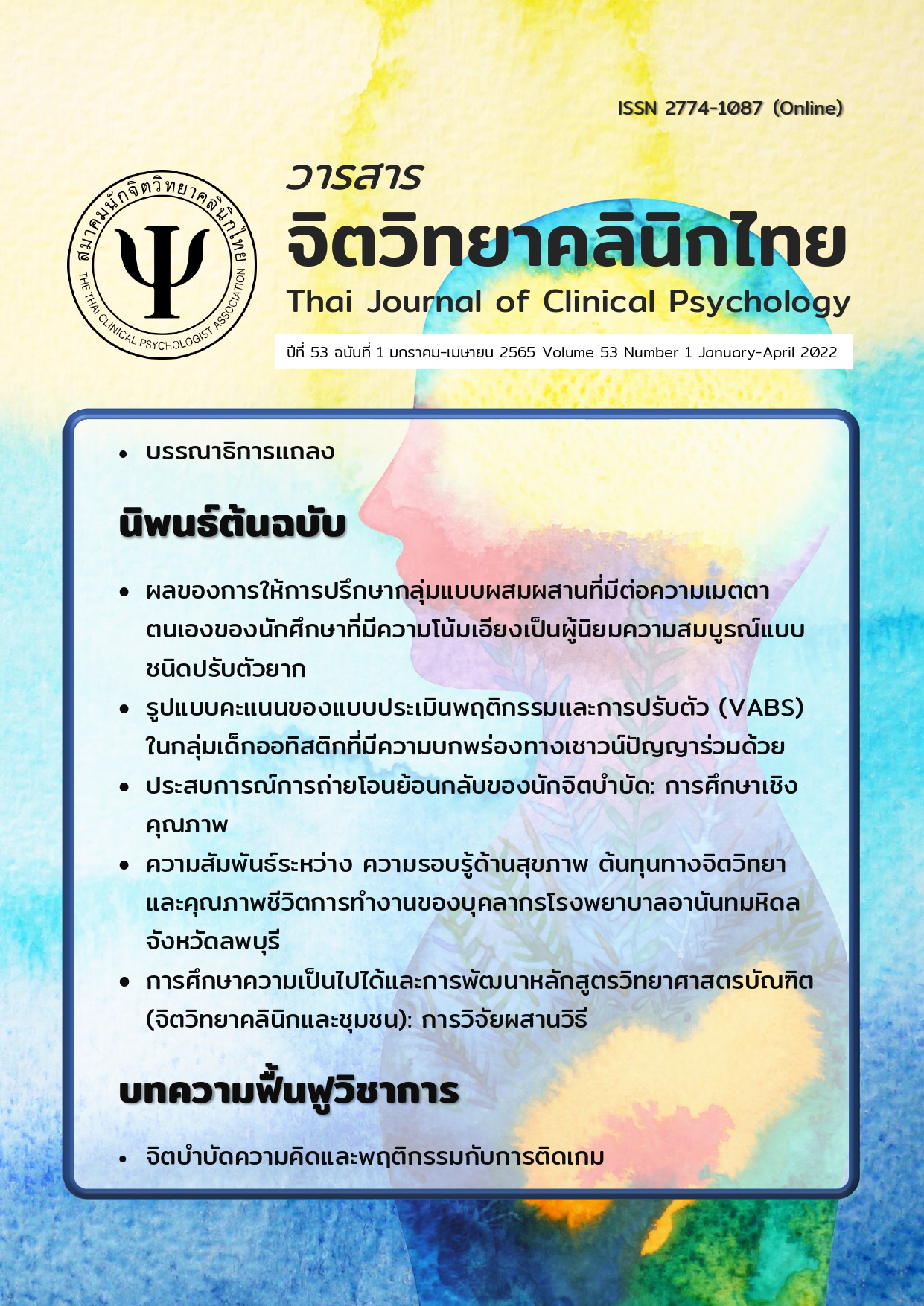Vineland Adaptive Behavior Profiles of Children with Autism Spectrum Disorder and Comorbid Intellectual Disability
Main Article Content
Abstract
Objectives: To investigate the adaptive behavior profiles of Vineland Adaptive Behavior Scales (VABS), the correlation between the adaptive behavior composite and the domains of VABS in children with Autistic Spectrum Disorder (ASD) and comorbid Intellectual Disability (ID). Materials and Methods: A retrospective, descriptive study of participants included children with ASD and comorbid ID (mild or moderate grade), ages ranged from 6 to 12 years. The VABS were recruited from the Psychological Unit, Rajanukul Institute, Thailand. Descriptive statistics, A Mann-Whitney U test and Pearson’s correlation coefficients were used to analyze data. Results: The sample consisted of 92 males and 17 females (mean age 7.75 years). Overall adaptive behavior composite was equivalent to age 3.29 years. The profile of VABS showed that the highest skill domain attained to daily living skills domain - equivalent to age 3.59 years followed by communication domain - equivalent to age 2.73 years and lastly socialization domain - equivalent to age 2.63 years. The pattern of profile showed that children with ASD and comorbid mild ID got the higher score than moderate ID in all domains, a statistically significant difference was detected (p < 0.01). The adaptive behavior composite correlated with communication domain (r = 0.835), daily living skills domain (r = 0.801) and socialization domain (r = 0.745). Furthermore, the correlation coefficient within all domains and subdomains were positive correlations for all variables (r > 0.5), a statistically significant difference was detected (p < 0.05). Conclusion: The VABS profile in the children with ASD and comorbid ID showed the overall adaptive behavior composite were lower than the chronological age. Daily living skills domain was the highest score. Communication domain was highly positive correlation with adaptive behavior composite.
Article Details

This work is licensed under a Creative Commons Attribution-NonCommercial-NoDerivatives 4.0 International License.
เรื่องที่ลงตีพิมพ์ในวารสารจิตวิทยาคลินิกแล้วถือเป็นลิขสิทธิ์การเผยแพร่โดยวารสารจิตวิทยาคลินิกแต่เพียงผู้เดียว การตีพิมพ์หรือเผยแพร่ซ้ำในที่อื่นต้องได้รับอนุญาตจากกองบรรณาธิการวารสารฯ
References
American Psychiatric Association. (2010). Diagnostic and Statistical Manual of Mental Disorders, Fourth Edition (DSM-IV) (4th ed.). American Psychiatric Pub.
American Psychiatric Association. (2013). Diagnostic and statistical manual of mental disorders (DSM-5®). American Psychiatric Pub.
Baron Cohen, S., Leslie, A. M., & Frith, U. (1985). Does the autistic child have a “theory of mind” Cognition, 21, 103–128.
Black, D. O., Wallace, G. L., Sokoloff, J. L., & Kenworthy, L. (2009). Brief report: IQ split predicts social symptoms and communication abilities in high-functioning children with autism spectrum disorders. Journal of Autism and Developmental Disorders, 39(11), 1613-1619. https://doi.org/10.1007/s10803-009-0795-3
Burack, J. A., & Volkmar, F. R. (1992). Development of low- and high-functioning autistic children. Journal of Child Psychology and Psychiatry, 33(3), 607-616. https://doi.org/10.1111/j.1469-7610.1992.tb00894.x
Carter, A. S., Dawson, G., Fombonne, E., Loveland, K., Mesibov, G., Schopler, E., Lord, C., Wang, J. J., Sparrow, S. S., & Volkmar, F. R. (1998, August 28). The Vineland Adaptive Behavior Scales: supplementary norms for individuals with autism. Journal of Autism and Developmental Disorders, 28, 287–302. https://doi.org/10.1023/a:1026056518470
Centers for Disease Control and Prevention. (2012, March 30). Prevalence of autism spectrum disorders--Autism and Developmental Disabilities Monitoring Network. PubMed. https://pubmed.ncbi.nlm.nih.gov/22456193/
Di Nuovo, S. F., & Buono, S. (2007). Psychiatric syndromes comorbid with mental retardation: Differences in cognitive and adaptive skills. Journal of Psychiatric Research, 41(9), 795-800. https://doi.org/10.1016/j.jpsychires.2006.02.011
Eccles, J. S. (1999). The development of children ages 6 to 14. The Future of Children, 9(2), 30. https://doi.org/10.2307/1602703
Gabriels, R. L., Ivers, B. J., Hill, D. E., Agnew, J. A., & McNeill, J. (2007). Stability of adaptive behaviors in middle-school children with autism spectrum disorders. Research in Autism Spectrum Disorders, 1(4), 291-303. https://doi.org/10.1016/j.rasd.2006.11.004
Kraijer, D. (2000, February). Review of adaptive behavior studies in mentally retarded persons with autism/Pervasive developmental disorder. Journal of Autism and Developmental Disorders, 30, 39–47.https://doi.org/10.1023/A:1005460027636
Loveland, K. A., & Kelley, M. L. (1991, July). Development of adaptive behavior in preschoolers with autism or Down syndrome. PubMed. https://pubmed.ncbi.nlm.nih.gov/1831619/
Manager Online. (2017, July 23). Rengvijai GENE cause of autism It is estimated that 3 hundred thousand Thai children will be diagnosed. Manager Online. https://mgronline.com/qol/detail/9600000074845
Mouga, S., Almeida, J., Café, C., Duque, F., & Oliveira, G. (2014). Adaptive profiles in autism and other neurodevelopmental disorders. Journal of Autism and Developmental Disorders, 45(4), 1001-1012.
https://doi.org/10.1007/s10803-014-2256-x
Ozonoff, S. & Jensen, J. (1999). Brief Report: Specific executive function profiles in three neurodevelopmental disorders. Journal of Autism and Developmental Disorders, 29, 171–177.
Perry, A., Flanagan, H. E., Dunn Geier, J., & Freeman, N. L. (2009). Brief report: The vineland adaptive behavior scales in young children with autism spectrum disorders at different cognitive levels. Journal of Autism and Developmental Disorders, 39(7), 1066-1078. https://doi.org/10.1007/s10803-009-0704-9
Rajanukul Institute, Yuwaprasart Waithayopathum Child and Adolescent Psychiatric Hospital, Child and Adolescent Mental Health Rajanagarindra Institute. (2011). Psychological Testing Manual for Children (Full Version) (1st ed.). Beyond Publishing CO., LTD.
Sparrow, S., Balla, D., & Cicchetti, D. (1984). Vineland Adaptative Behaviour Scales: Interview edition, survey form. American Guidance Service.

